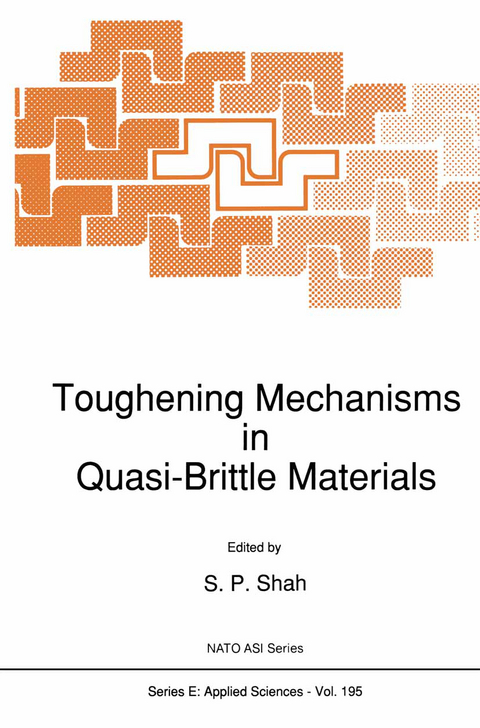
Toughening Mechanisms in Quasi-Brittle Materials
Springer (Verlag)
978-94-010-5498-0 (ISBN)
A variety of ceramic materials has been recently shown to exhibit nonlinear stress strain behavior. These materials include transformation-toughened zirconia which undergoes a stress-induced crystallographic transformation in the vicinity of a propagating crack, microcracking ceramics, and ceramic-fiber reinforced ceramic matrices. Since many of these materials are under consideration for structural applications, understanding fracture in these quasi-brittle materials is essential. Portland cement concrete is a relatively brittle material. As a result mechanical behavior of concrete, conventionally reinforced concrete, prestressed concrete and fiber reinforced concrete is critically influenced by crack propagation. Crack propagation in concrete is characterized by a fracture process zone, microcracking, and aggregate bridging. Such phenomena give concrete toughening mechanisms, and as a result, the macroscopic response of concrete can be characterized as that of a quasi-brittle material. To design super high performance cement composites, it is essential to understand the complex fracture processes in concrete. A wide range of concern in design involves fracture in rock masses and rock structures. For example, prediction of the extension or initiation of fracture is important in: 1) the design of caverns (such as underground nuclear waste isolation) subjected to earthquake shaking or explosions, 2) the production of geothermal and petroleum energy, and 3) predicting and monitoring earthquakes. Depending upon the grain size and mineralogical composition, rock may also exhibit characteristics of quasi-brittle materials.
Session 1: Fracture of Ceramics with Process Zone.- Fracture Properties of SiC-Based Particulate Composites.- Crack Bridging Processes in Toughened Ceramics.- Fracture Process Zone in Concrete and Ceramics - A Matter of Scaling.- Report on Session 1: Fracture of Ceramics with Process Zone.- Session 2: Fracture in Concrete and Rock.- Microcracking and Damage in Concrete.- Cracking, Damage and Fracture in Stressed Rock: A Holistic Approach.- Test Methods for Determining Mode I Fracture Toughness of Concrete.- Report on Session 2: Fracture in Concrete and Rock.- Session 3: Theoretical Fracture Mechanics Considerations.- Rate Effect, Size Effect and Nonlocal Concepts for Fracture of Concrete and Other Quasi-Brittle Materials.- Micromechanics of Deformation in Rocks.- Asymptotic Analysis of Cohesive Cracks and its Relation with Effective Elastic Cracks.- Reporter’s Summary: Session 3, Theoretical Fracture Mechanics Considerations.- Session 4: Experimental Observations.- Microstructure, Toughness Curves and Mechanical Properties of Alumina Ceramics.- Creep Damage Mechanisms in Hot-Pressed Alumina.- Study of the Fracture Process in Mortar with Laser Holographic Measurements.- Reporter’s Comments on Session 4 - Experimental Observations.- Session 5: Experimental Methods to Assess Damage.- The Fracture Process Zone in Concrete.- Characterization of the Fracture Behavior of Ceramics Through Analysis of Crack Propagation Studies.- A Review of Experimental Methods to Assess Damage During Fracture of Rock, Concrete and Reinforced Composites.- Similarities Between Fracture Processes in Concrete, Rock and Ceramics: Recorders Report to Session 5 ‘Experimental Methods to Assess Damage.- Session 6: Theoretical Micromechanics Based Models.- A Review of Some Theories of TougheningMechanisms in Quasi-Brittle Materials.- On the Form of Micromechanical Models of the Brittle Deformation of Solids.- On the Relationship Between Fracturing of A Microcracking Solid and its Effective Elastic Constants.- Report of Session 6: Theoretical Micromechanics Based Models.- Session 7: Fracture Process in Fiber Reinforced Ceramics.- Determination of Fiber-Matrix Interfacial Properties of Importance to Ceramic Composite Toughening.- Quasi-Ductile Behaviour of Carbon-Reinforced Carbon.- The Fracture Resistance and Brittle Matrix Composites.- Session 7 Discussion.- Session 8: Fracture Toughness of Fiber-Reinforced Cement Composites.- Research Challenges in Toughness Development of Fiber Reinforced Cementitious Composites.- Failure Characterisation of Fibre-Reinforced Cement Composites with R-Curve Characteristics.- Characterization of Interfacial Bond in FRC Materials.- Summary of Session 8: Fracture Toughness of Fiber-Reinforced Cement Composites.- Session 9: Strain Rate, Thermal, Time and Fatigue Effects.- Growth of Discrete Cracks in Concrete under Fatigue Loading.- Creep and Creep Rupture of Structural Ceramics.- Fracture of Concrete at High Strain-Rate.- Summary of Session 9: Strain Rate, Thermal, Time, and Fatigue Effects.- Author Index.
| Erscheint lt. Verlag | 5.11.2012 |
|---|---|
| Reihe/Serie | NATO Science Series E ; 195 |
| Zusatzinfo | XI, 612 p. |
| Verlagsort | Dordrecht |
| Sprache | englisch |
| Maße | 155 x 235 mm |
| Themenwelt | Naturwissenschaften ► Geowissenschaften ► Geologie |
| Naturwissenschaften ► Physik / Astronomie ► Mechanik | |
| Technik ► Maschinenbau | |
| ISBN-10 | 94-010-5498-3 / 9401054983 |
| ISBN-13 | 978-94-010-5498-0 / 9789401054980 |
| Zustand | Neuware |
| Haben Sie eine Frage zum Produkt? |
aus dem Bereich


